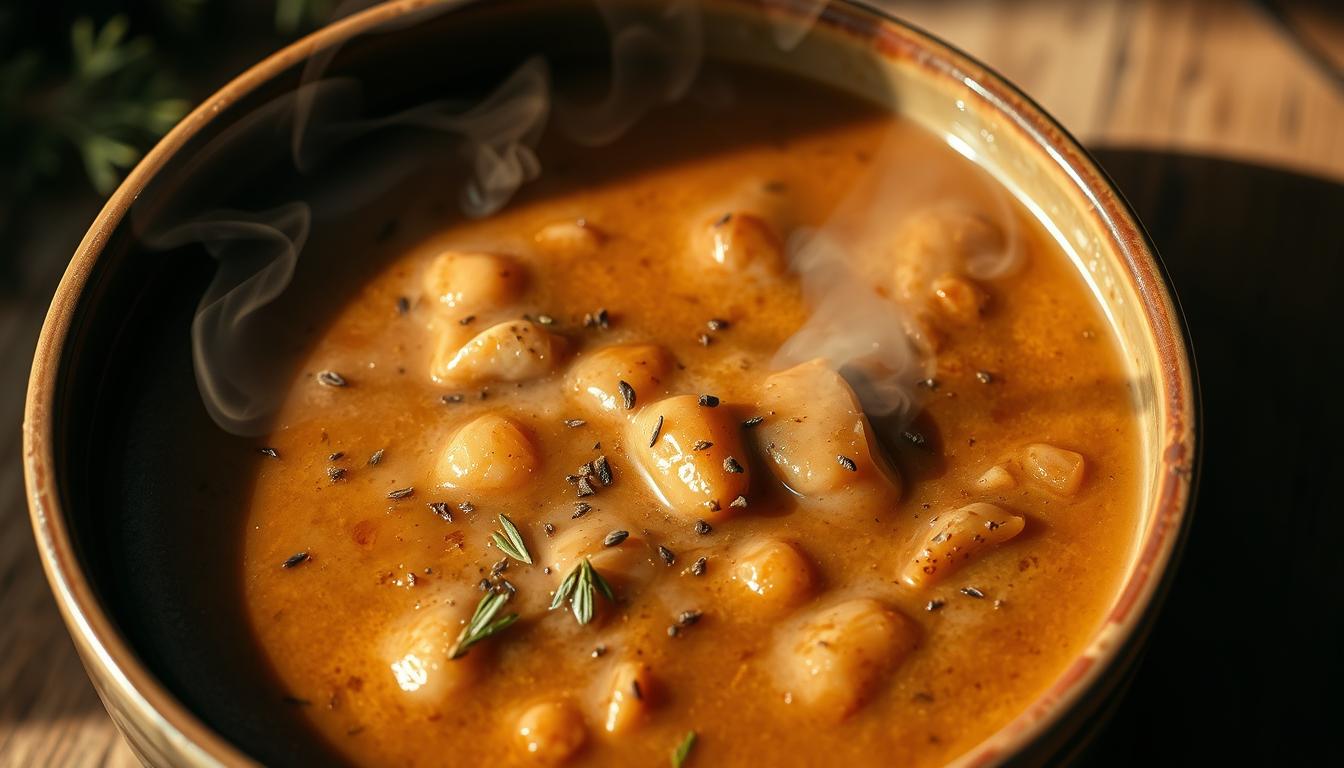Turkey Neck Gravy: A Simple and Savory Recipe
There are smells that take you back. You remember the pan on the stove, the sizzling fat, and the hush at the table as everyone waits for that first spoonful. That feeling is what drives this guide: you want a reliable, deeply flavored sauce that feels like home.
You’ll learn how to build a rich stock by browning neck pieces, then simmering them with onion, celery, carrots, bay leaf, poultry seasoning, peppercorns, salt, and reduced-sodium broth. Strain that stock and use a classic roux—half cup fat and half cup flour—then whisk in about four cups of hot stock and any cherished drippings.
This section shows practical swaps and timing so you know when the roux is light golden and when the sauce is ready in minutes. You’ll also get storage tips for the freezer and fridge, plus ways to adjust thickness so your holiday plate shines.
Table of Contents
Why You’ll Love This Turkey Neck Gravy
Begin by coaxing flavor from browned meat and vegetables—this is the secret to a rich, dependable sauce. Simmering neck pieces with onion, celery, carrots, herbs, and seasonings creates a deep, velvety stock that becomes the backbone of great turkey neck gravy.
Pan drippings add another layer. Scrape browned bits and whisk them into the sauce for instant savory depth. That step turns good stock into something memorable.
What makes it rich, savory, and foolproof
- Deep stock: Aromatics and browned pieces give rich base taste before you add drippings.
- Browning: A quick sear boosts roasted complexity so the sauce feels like holiday cooking.
- Giblet option: Simmer giblets about an hour, chop them, and stir in for classic savor; leave out the liver for a milder profile.
- Versatile use: Spoon over sliced turkey, mashed potatoes, or stuffing, and enjoy on leftover sandwiches.
“A glossy, lump-free sauce is mostly about timing and steady whisking—simple steps lead to consistent results.”
Ingredients and Smart Substitutions
Gathering the right items makes the process easier and the results more reliable. Start with browned turkey neck pieces, onion, celery (with leaves), and carrots to form a savory stock base.
Stock essentials:
- Brown necks in oil to create fond, then add bay leaf, poultry seasoning, peppercorns, salt, and fresh thyme, parsley, and sage.
- Use reduced-sodium chicken broth or water plus a bouillon paste for consistent flavor.
- Simmer covered 45 minutes to 2 hours, then strain through a fine mesh and reserve the liquid.
Gravy basics and swaps:
- Use about 1/2 cup fat from drippings or butter and 1/2 cup all-purpose flour (gluten-free 1:1 works).
- Gradually whisk in 3–4 cups hot neck stock and any pan juices; simmer to desired thickness.
- Boost depth with Better than Bouillon (turkey or chicken) if you lack drippings. Season with salt and pepper at the end.

Step-by-Step: Make Stock from Turkey Necks
Good stock starts with heat and patience. Heat 1 tablespoon oil in a heavy pot or saucepan until it shimmers. Brown the meat well on all sides to create fond in the pan; that browned crust gives clear, rich flavor to the broth.

Build aromatics and liquid, then bring to a boil
Add chopped onion, celery, and carrot with a bay leaf, poultry seasoning, peppercorns, and a pinch of salt. Pour in either 4 cups reduced-sodium chicken broth plus 1.5 cups water, or 4 cups water with a spoonful of Better than Bouillon.
Reduce heat and simmer for deep extraction
Stir, bring to a lively boil, then reduce heat to a gentle simmer and cover. Cook 45 minutes for a quick stock or up to 2 hours for more body and gelatin.
Skim foam or excess fat as it rises so the liquid stays clear.
Strain and reserve your clear stock
Strain the liquid through a fine mesh into a heatproof bowl. Press lightly on solids to capture all the liquid, then discard the vegetables and bones or pick any tender bits of meat to fold into your sauce later.
Keep the stock warm if you will make the sauce right away. If storing, cool quickly, label, and refrigerate or freeze.
“A clear, flavorful stock is the backbone of any great sauce—take the extra minutes to brown and skim.”
| Time | Result | Tip |
|---|---|---|
| 45 minutes | Lightly flavored, good for quick gravy | Use if short on time; skim well |
| 1–1.5 hours | Richer, more body and mouthfeel | Great for thicker sauces |
| 2 hours | Deep extraction, gelatinous when cold | Best when making ahead and chilling |
| Storage | Refrigerate 3–4 days, freeze 3 months | Label with date and volume |
Make the Gravy from Drippings or Without Drippings
Ready to turn your stock into a glossy, well-seasoned sauce? Warm a heavy saucepan and gather fat, flour, hot broth, and any pan juices. Working steadily keeps the texture silky and lump-free.
Create a roux
In a saucepan, melt about 1/2 cup fat from turkey drippings or butter over medium heat. Add 1/2 cup all-purpose flour and cook 3–4 minutes until light golden; a pinch of ground sage is optional.
Whisk while adding broth
While whisking constantly, stream in about 4 cups hot neck broth a little at a time. Add reserved pan juices and scrape browned bits from the roasting pan for extra depth.
Giblet option
Stir in chopped giblets and any cooked neck meat; discard liver if you prefer a milder profile. Simmer 5–8 minutes so flavors meld.
Adjust thickness and seasoning
If the sauce is too thin, simmer briefly or add a small cornstarch slurry. Thin with more broth or water as needed. Taste and finish with salt and pepper toward the end.
- Tip: No drippings? Use a knob of butter and Better than Bouillon for lift.
- Gluten-free: Swap flour for a 1:1 gluten-free blend and follow the same roux method.
“A steady hand and hot liquid make the difference between a lumpy sauce and a smooth, rich finish.”
Variations and Pro Tips for turkey neck gravy
A few smart swaps let you tailor the sauce to dietary needs and pantry limits without losing depth. Use drippings when you have them: reserve the clear fat for the roux and the pan juices as part of your liquid. If you lack drippings, your neck stock alone still makes a full-flavored sauce; add Better than Bouillon for extra backbone.
With drippings vs. no drippings
If you have drippings, use about 1/2 cup fat to make the roux and replace part of the broth with the juices. Without drippings, melt butter or use a tablespoon of oil, then add flour and whisking constantly while you stream in hot stock.
Gluten-free swap and lump-free tips
For gluten-free, use a 1:1 all-purpose blend and build the roux the same way. Prevent lumps by adding hot liquid slowly and whisking constantly; a flat whisk helps reach corners for a smooth sauce.
Flavor boosters and timing
Add chopped giblets or meat at the end to keep tenderness. Brighten with fresh parsley, thyme, or a pinch of sage and season with salt and pepper at the finish. For Thanksgiving timing, make stock ahead and finish the sauce in the roasting pan to scrape every browned bit.
“Skim and separate drippings: use clear fat for the roux and juices for liquid to keep flavors clean and balanced.”
| Scenario | Action | Result |
|---|---|---|
| Have drippings | Use fat for roux; add juices to broth | Deeper, glossy sauce |
| No drippings | Use butter/oil + Better than Bouillon | Full flavor without roast juices |
| Gluten-free | Use 1:1 GF flour; whisk well | Smooth texture, same method |
| Too thin | Simmer or add cornstarch slurry | Thicker, clingy sauce |
Storage, Make-Ahead, and Reheating
Handle cooling and storage with care to keep flavor and food safety on track. Cool the sauce quickly and move it to an airtight container so you limit time at room temperature. Do not leave the sauce out more than two hours.
Refrigerator tips
Store in a covered or airtight container in the refrigerator for up to 3–4 days. Label the container with the date so you track freshness during busy holiday time.
If you kept meat or giblets separate, fold them into the sauce when reheating to keep texture bright.
Freezing for busy days
For longer storage, cool and portion into zip-top bags or ice cube trays. Freeze for 2–3 months. Thawed portions thaw faster when flattened in a bag or moved to the fridge overnight.
Reheat gently
Warm in a saucepan over low to medium-low heat, whisking until smooth. If the sauce has thickened, add warm chicken broth or water, a tablespoon at a time, until the consistency is right.
Taste and adjust with a pinch of salt and a grind of pepper. Reheat only what you plan to serve and return leftovers promptly to the refrigerator.
“Make the sauce up to two days ahead; add a few tablespoons of warm liquid when reheating and heat about 15 minutes until smooth.”
| Storage Method | Duration | Best Use | Quick Tip |
|---|---|---|---|
| Refrigerator (airtight container) | 3–4 days | Serve within holiday week | Label with date; cool quickly |
| Freezer (zip bag/ice cubes) | 2–3 months | Portion for small servings | Flatten bags to thaw faster |
| Make-ahead | Up to 2 days | Finish on day of serving | Keep meat separate until reheating |
| Reheating | 15 minutes approx. | Restore texture and heat | Whisk in broth or water by tablespoons |
Conclusion
A simple, repeatable approach—browned meat, reduced stock, and a golden roux—yields consistent results. You get deep savory flavor by starting with a neck-based stock, building a golden mix of flour and fat, and whisking in hot broth until the sauce is silky.
Fold in chopped giblets and neck meat for classic giblet gravy, or skip them for a milder finish. Scrape the pan to capture every roasted bit and boost taste with reserved drippings.
Serve generously over carved turkey, into a well in mashed potatoes, and across stuffing. Make the recipe ahead, store chilled or frozen, and reheat gently with a splash of broth to add gravy back to perfect pouring consistency for Thanksgiving and weeknight meals.







